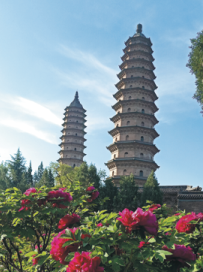Springtime sightseeing begins as virus spread brought under control
Updated: 2020-04-10

Blossoming peony flowers make the Double Pagodas Temple a popular attraction in Taiyuan. [Photo by Ji Meijun for China Daily]
With the nationwide novel coronavirus epidemic showing signs of being under control, residents in Taiyuan, capital city of Shanxi province, are going out sightseeing as spring flowers start to bloom.
A popular destination is the Double Pagodas Temple in the southeast of the city.
"Every late April when the peony flowers blossom, the Buddhist temple is a must-see place for me," said Bai Jie, a local resident.
He added he will visit the site several times in April to take photos of peony flowers.
Although China does not have an official national flower, peonies are a national favorite. The flower received the most votes in a survey conducted in 1994 asking people to select a national flower-a high honor for the peony in a country where people are especially fond of flowers.
The most renowned variety of peony at the Double Pagodas Temple is called the "purple cloud fairy", which is said to have a history of more than 300 years.
Purple cloud fairy peony flowers are mostly located in front of the main hall of the temple.
The temple has more than 30 other varieties of flowers.
The temple got its name for its two Buddhist pagodas, which were built in the late Ming Dynasty (1368-1644) and early Qing Dynasty (1644-1911).
The two pagodas have been landmarks of Taiyuan for more than 300 years.
The pagoda in the north is called the Sarira Pagoda as it houses the sarira of Sakyamuni. Sarira are the bone relics after the cremation of Buddha or saintly monks.
The other in the south is called the Peak of Culture Pagoda, which was built under the sponsorship of Fu Lin, a local scholar and official during the early Qing Dynasty.
It is said the construction of the Peak of Culture Pagoda was aimed to lift Taiyuan's status as a cultural city and improve the "cultural fortune" of the sponsor's family.
Coincidentally, several decades after the construction, Fu's grandson Fu Shan became one of the country's top scholars, poets, calligraphers and painters of his time.
The story has made the temple a favorite among local intellectuals and residents who wish for good academic fortune for their children.
The temple's collection of more than 260 stone tablets with inscriptions of renowned calligraphic works from the past millennium is a must-see attraction for calligraphy enthusiasts.
Li Yali contributed to this story.



